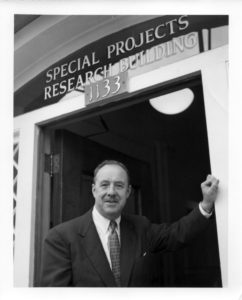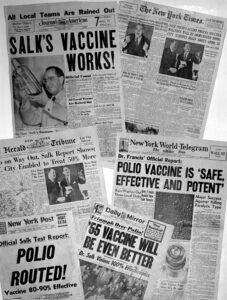Where Did Thomas Francis Jr Develop a Vaccine for the Flu
"Epidemiology must constantly seek imaginative and ingenious teachers and scholars to create a new genre of medical ecologists who, with both the fine sensitivity of the scientific artist, and the broad perception of the community sculptor, can interpret the interplay of forces which result in disease."
—Thomas Francis, Jr.
 A physician, virologist, and epidemiologist, Thomas Francis Jr.—T.F. or Tommy to his friends—was born in Gas City, Indiana. The son of a steelworker and part-time minister, Francis grew up in western Pennsylvania, graduated from Allegheny College on scholarship in 1921, and received his medical degree from Yale in 1925. From there he went to the Rockefeller Institute, where he joined an elite research team then preparing vaccines against bacterial pneumonia. Francis soon switched diseases, however, and took up influenza research. He became the first American to isolate human flu virus.
A physician, virologist, and epidemiologist, Thomas Francis Jr.—T.F. or Tommy to his friends—was born in Gas City, Indiana. The son of a steelworker and part-time minister, Francis grew up in western Pennsylvania, graduated from Allegheny College on scholarship in 1921, and received his medical degree from Yale in 1925. From there he went to the Rockefeller Institute, where he joined an elite research team then preparing vaccines against bacterial pneumonia. Francis soon switched diseases, however, and took up influenza research. He became the first American to isolate human flu virus.
In 1933, Francis married Dorothy Packard Otton, and they had two children. By 1938, he had become a professor of bacteriology and chair of the department of the New York University College of Medicine, where he remained until 1941.
That year, Francis received an invitation from Henry F. Vaughan to join the newly established School of Public Health at the University of Michigan. Earlier in the year, he had also been appointed director of the Commission on Influenza of the United States Army Epidemiological Board. Under the auspices of the commission, Francis took part in the successful development, field trial, and evaluation of protective influenza vaccines.
At Michigan, Francis built a virus laboratory and a Department of Epidemiology that quickly focused on a broad range of infectious diseases. When Jonas Salk came to the University of Michigan in 1941 to pursue postgraduate work in virology, it was Francis who taught him the methodology of vaccine development. Salk's work at Michigan ultimately led to his polio vaccine.

From his Ann Arbor base, Francis gained national and international renown. In 1947, the Regents of the University awarded him one of the first Michigan distinguished professorships, naming him the Henry Sewall University Professor of Epidemiology. In addition to his work at the School of Public Health, Francis joined the pediatrics faculty at the University's Medical School.
By the late 1940s, Francis had extended his studies of viral disease to include studies of enteric viruses, particularly the polio virus. In 1953, he was asked to design, supervise, and evaluate the field trials of the polio vaccine developed by his former protegé, Jonas Salk. A man of exacting standards, Francis insisted on a double-blind means of statistical analysis, so that neither patients nor administering physicians knew whether an inoculation was a vaccine or a placebo. He also demanded a controlled observation trial. Approximately 1.8 million children from 217 areas of the United States, Canada, and Finland took part in the trial. In scope and magnitude, it was unprecedented. On April 12, 1955, Francis announced to an expectant world that the Salk vaccine was "safe, effective, and potent."
Six months later, Francis visited Japan at the behest of the U.S. government's Atomic Bomb Casualty Commission. Charged with determining new objectives and a new strategy for the commission, Francis authored the "Unified Study Program," which contained plans to investigate the natural history of a population over its lifespan.
Francis subsequently turned to the study of the epidemiology of chronic disease, and he created the Tecumseh Study. His aim was to build a community laboratory in the town of Tecumseh, Michigan, which could take advantage of geography, history, and local culture to lay the groundwork for accumulated data from which it would be possible over a period of years to draw secure inferences on disease precursors. Through the Tecumseh Study, Francis contributed profoundly to scientists' understanding of the epidemiology of chronic disease, and furthered his renown as a scientist, investigator, and innovator.
Throughout these years, Francis taught and served as an exemplary administrator at the University of Michigan. He received many honors and awards during his career, notably the Medal of Freedom from the U.S. Army in 1946. About his profession, Francis remarked, "Epidemiology must constantly seek imaginative and ingenious teachers and scholars to create a new genre of medical ecologists who, with both the fine sensitivity of the scientific artist, and the broad perception of the community sculptor, can interpret the interplay of forces which result in disease." Thomas Francis Jr. died in 1969.
Thomas Francis Jr.'s Legacy at Michigan
- Perspective: Tommy Francis and the Salk Vaccine (PDF)
- Thomas Francis, Jr.: An Appreciation (PDF)
"Dr. Francis made us into people who question things, who took nothing for granted."
—Arnold S. Monto Thomas Francis Jr. Collegiate Professor of Public Health
Arnold Monto, professor of epidemiology, came to the University of Michigan because he wanted to continue his research on respiratory infections, and Thomas Francis gave him the opportunity to do that as part of the landmark Tecumseh Community Health Survey.
The Tecumseh study, begun in 1956 and led by Francis, looked at behavioral, environmental, and family factors associated with cardiovascular disease and other chronic conditions. Monto talked to Francis about expanding its scope, and he studied the spread of respiratory infections in 10,000 residents of Tecumseh, Mich. in the 1960s and 1970s.
Dr. Monto's seminal work led to an understanding of human herd immunity. Monto is one of the world's leading flu researchers, carrying on the Francis tradition at Michigan
"He had a profound influence on what people worked on here," Monto said.
Monto described Francis as a demanding leader—he would not allow for sweeping generalizations in scientific results, instead insisting upon the evidence to back everything up.
"He made us into people who question things, who took nothing for granted," Monto said.
"The prevention and control of viral diseases is an important evolving public health effort. Infectious diseases are an increasing public health problem. My work can serve as an example for others to follow."
—Hunein F. "John" Maassab, Professor Emeritus (deceased)
Hunein "John" Maassab was a research assistant for Thomas Francis while he was a graduate student at Michigan. Maassab helped work on the data for the polio vaccine trials, and was in the audience at Rackham Auditorium for the historic announcement in 1955 that the vaccine worked.
Maassab completed his doctoral work 1956, including a dissertation on influenza. He was inspired by Francis, who had overseen the U.S. Army's flu vaccine program during World War II.
After Francis developed the first killed-virus flu vaccine, he told Maassab that the next logical step would be a vaccine using a live virus. Maassab ultimately spent his entire career developing a live-attenuated, cold-adapted flu vaccine, the technology behind the nasal spray flu vaccine FluMist.
"My work started with a job offer from Dr. Thomas Francis Jr. to join the department of epidemiology after receiving my Ph.D. in 1956," Maassab said. "Dr. Francis asked me to work on a live flu vaccine because the killed virus vaccine was not completely effective. Some people who got the killed virus vaccine were not protected. They got the flu.
"The prevention and control of viral diseases is an important evolving public health effort. Infectious diseases are an increasing public health problem. My work can serve as an example for others to follow."
"They will still marvel at the audacity of a field trial that kept track of 1.8 million children before the days of computers."
—William Foege, 2005 recipient, Thomas Francis Jr. Medal"Here at Michigan, Dr. Thomas Francis Jr. declared famously that the Salk vaccine was safe, effective, and potent; a classic phrase that has gone down in public health history."
—Alfred Sommer, 2010 recipient, Thomas Francis Jr. Medal"The Thomas Francis, Jr. Medal in Global Health reminds us that remedies may not easily be forthcoming, but they are within our reach if we can summon the generosity of spirit and the political will to pursue them."
—Kenneth Warner, 2010, Dean, School of Public Health, and Avedis Donabedian Distinguished University Professor
Where Did Thomas Francis Jr Develop a Vaccine for the Flu
Source: https://president.umich.edu/honors-awards/francis-medal/about-thomas-francis-jr/
0 Response to "Where Did Thomas Francis Jr Develop a Vaccine for the Flu"
Publicar un comentario